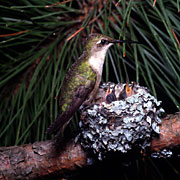
Well, there’s no longer any doubt – spring has arrive in Lazy Horse Hollow. While leaf-out is far from complete up here in the mountains, every tree has leaves, the trillium are finally in bloom and the water level in the south fork of the New River is back up to canoe-friendly levels.
Unfortunately, the recent rains have turned the river water back to the color of chocolate milk. When the water looks like chocolate milk when it rains, it means there are some serious problems in the watershed. In the case of the south fork of the New River, it’s no mystery as to the cause – the booming development around Boone and Blowing Rock, NC, are putting extraordinary pressure on the watershed. If folks around here don’t know about the National Committee for the New River they ought to follow that link and learn more.
But back to the happier subject of spring in the mountains, the bird life out in the forest is changing by the day. While most of the white-throated sparrows have moved on to the north, it looks like the ruby-throated hummingbirds are back and here to stay – thought I’d write a little about these wonderful birds this week.
Ruby-throated hummingbirds spend their winters in Central and South America and on the Caribbean Islands. It’s hard to imagine these tiny birds migrating such a long distance – across the Gulf of Mexico – which has historically given rise to the myth that they actually “hitch-hike” on the backs of other birds. While this fanciful myth has no grain of truth to it at all, it may actually be more amazing that they can make the trip on their own. At rest, the hummingbird’s heart will beat between 200 and 400 times per minute – imagine what their heart rate must be like when they’re half-way through migrating across the Gulf of Mexico!
The hummingbirds here in Lazy Horse Hollow spend a lot of time at the lilac bush. As many gardeners know, planting red and reddish flowers is an excellent way to attract these nectar-feeding birds to your garden. Hummingbirds are able to feed on flowers because of a unique ability to move their wings in a figure-8 pattern, which is what enables them to hover in one place for a long period of time.

When hummingbirds are breeding, however, they feed on a lot more than flower nectar. Insects and spiders become an important part of females’ diets when they’re producing eggs, and their ability to hover makes it a lot easier for them to pick spiders out of webs. These prey provide the large amounts of lipid (or fats) that go into the yolk and the proteins that go into the albumin (or “egg white” to those who rarely think about eggs except around breakfast time) – nutrients that are scarce in the sugary nectar that these birds mostly feed on other times of year. Hummingbirds will also eat bits of eggshell and even snail shell in order to get enough calcium to produce eggs (the shells of birds’ eggs are made of calcium carbonate, which means they have to eat a lot of calcium to produce a healthy egg).
Other interesting facts about ruby-throated hummingbirds are that they weigh only about 3.1 grams and they maintain an average body temperature of about 107º Fahrenheit. Also, the magnificent metallic red that you see on their throats is what ornithologists call a “structural color.” While we typically think of colors coming from pigments, like the dyes we use to color our clothes, birds can modify the structure of the keratin layers in their feathers to refract light in ways that produce many colors, including the iridescence of hummingbirds.
So get outside in the garden this weekend and enjoy this recent invasion of ruby-throated hummingbirds – they’re only here for four or five months before they return back to the more comfortable temperatures of the tropics. I’ll be back next week with more news of visitors to Lazy Horse Hollow and the rest of these ancient and wonderful mountains we call home.



Leave a Reply